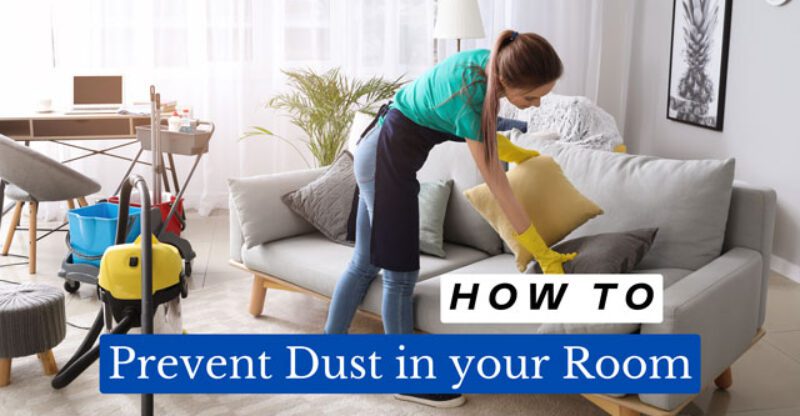How to Prevent Dust in Your Room?
Have you ever noticed a thin layer of dust settling on your furniture just hours after you’ve finished cleaning? This can be frustrating, but it’s also a common problem.
Dust is a mixture of particles that can come from various sources, both indoor and outdoor. Not only is it unsightly, but it can also negatively affect your health and indoor air quality.
Preventing dust in your room is important for several reasons. Firstly, dust can cause allergies and respiratory problems, especially for those with asthma or other respiratory conditions.
Secondly, dust can damage electronics, furniture, and other household items by clogging air vents and causing overheating. Lastly, a clean and dust-free room is more visually appealing and can improve your overall well-being.
Fortunately, there are many solutions to prevent dust from accumulating in your room. In this blog post, we will cover various methods such as cleaning, home improvements, and lifestyle changes to help you keep your room clean and dust-free.
Understand the Sources of Dust
Outdoor Sources of Dust
Outdoor sources of dust include pollen, dirt, and other particulate matter that can be carried in by wind or tracked in on shoes. While it’s impossible to eliminate outdoor dust, there are ways to minimize its impact, such as placing doormats at entrances, regularly sweeping or vacuuming floors and surfaces, and keeping windows and doors closed during peak pollen seasons.
Indoor Sources of Dust
Indoor sources of dust can come from a variety of sources, including human skin cells, pet dander, and even household products such as cleaning supplies and air fresheners. Dust can also accumulate from uncleaned air ducts, dirty furnaces or air conditioner filters, and poorly maintained appliances. To reduce indoor dust, it’s important to keep surfaces and floors clean, regularly change air filters, and have your air ducts and appliances regularly maintained.
Common Misconceptions about Dust Sources
One common misconception about indoor dust is that it comes primarily from outdoor sources. However, research shows that the majority of indoor dust is generated inside the home. Additionally, many people believe that dust is just dirt or sand when in reality it is made up of a complex mixture of particles, including skin cells, fibers, and other organic matter.
Dust Prevention through Cleaning
Tips for Effective Cleaning
Regular cleaning is an essential component of preventing dust in your room. When cleaning, it’s important to use methods that capture dust rather than spreading it around. Dry dusting can often make things worse by sending dust particles airborne. Instead, use a damp cloth or microfiber cloth to capture dust particles.
Tools to Use for Cleaning
In addition to using the right cleaning methods, having the right tools can make all the difference. A high-quality vacuum cleaner with a HEPA filter can effectively capture dust and allergens from floors and carpets. A microfiber mop or cloth can be used for dusting hard surfaces, and a soft-bristled brush can be used to clean electronic devices and other hard-to-reach areas.
Frequency of Cleaning
How often you need to clean your room depends on a variety of factors, such as the size of your room, the number of people and pets living in it, and your outdoor environment. In general, it’s recommended to clean your room at least once a week, but you may need to do it more frequently if you have allergies or live in a particularly dusty area.
Importance of Consistency
Consistency is key when it comes to preventing dust in your room. Regular, consistent cleaning can help prevent dust buildup and keep your room clean and healthy. It’s also important to make sure everyone in your household is on the same page about cleaning habits and expectations to maintain a clean and dust-free living space.
Dust Prevention through Home Improvements
Air Filtration Systems
Air filtration systems can be a great investment for preventing dust in your room. These systems work by trapping dust particles and other contaminants in the air, preventing them from circulating throughout your home.
There are a variety of air filtration systems available, including HEPA filters, electrostatic air filters, and UV air purifiers. It’s important to choose a system that’s appropriate for your specific needs and the size of your room.
Sealing Gaps and Cracks
Gaps and cracks in walls, floors, and ceilings can allow dust to enter your home from the outside. Sealing these gaps and cracks can help prevent dust from entering your home and improve your overall indoor air quality.
Common areas to check for gaps and cracks include around doors and windows, along baseboards and crown molding, and around electrical outlets and switches.
Using Floor Mats
Placing floor mats at entrances to your home can help prevent dust and dirt from being tracked in on shoes. Choose a durable mat with a textured surface to trap dirt and debris, and make sure to regularly clean and replace mats as needed.
Lifestyle Changes to Prevent Dust
Removing Shoes at the Door
Removing your shoes at the door can significantly reduce the amount of dirt and dust that enters your home. Shoes can track in dirt, pollen, and other outdoor pollutants that can contribute to indoor air pollution. Consider placing a shoe rack or mat near your front door to encourage this healthy habit.
Keeping Pets Groomed
Pets can be a major source of dust and dander in your home. Keeping your pets groomed, brushing them regularly, and bathing them as needed can help reduce the amount of pet hair and dander in your home. Additionally, consider keeping your pets off of furniture and beds to minimize their impact on your indoor air quality.
Smoking Outside
Smoking can release a variety of harmful chemicals and pollutants into your home, including dust and particulate matter. If you or someone in your household smokes, consider smoking outside or quitting altogether to improve your indoor air quality.
Conclusion
Preventing dust in your room is important for your health and well-being. Dust can contain a variety of harmful pollutants, including allergens, pet dander, and chemicals. It’s important to keep your home well-ventilated and to avoid using products that contain harmful chemicals.
Take the first step towards preventing dust in your room by implementing some of the solutions we’ve discussed in this post. By making small changes to your cleaning routine and lifestyle habits, you can significantly improve your indoor air quality and enjoy a cleaner, healthier living space.
FAQs
Natural cleaning products can be effective at reducing dust buildup, but they may not be as effective as traditional cleaning products. Consider using a combination of natural and traditional cleaning products to effectively remove dust and other pollutants from your indoor environment.
Yes, washing bedding and curtains regularly can help remove dust, pollen, and other allergens from your indoor environment. Consider washing these items at least once a week in hot water to effectively remove any buildup of dust and other pollutants.
Yes, air purifiers can help remove dust and other pollutants from your indoor air. Look for air purifiers with HEPA filters to effectively capture dust and other allergens.



